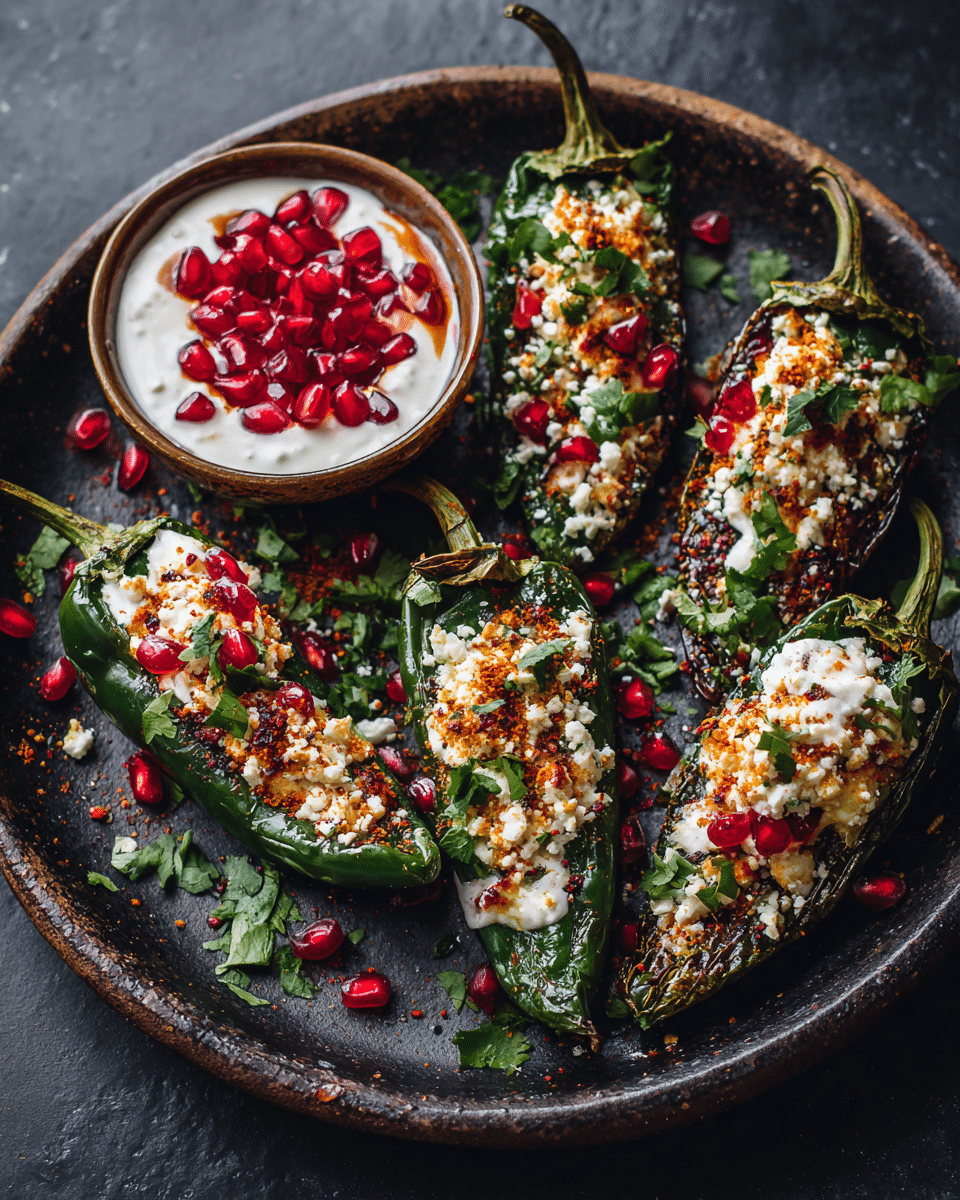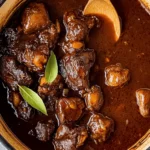Chiles en Nogada is one of Mexico’s most iconic and patriotic dishes, often enjoyed during Mexican Independence Day celebrations. This colorful plate features roasted poblano peppers stuffed with a savory-sweet picadillo filling made from ground meat, fruits, and spices, topped with a luscious walnut cream sauce (nogada) and sprinkled with ruby-red pomegranate seeds.
FULL RECIPE
Ingredients
1.For the Picadillo Filling:
- 6 large poblano peppers
- 2 tablespoons vegetable oil
- 1 medium white onion, finely chopped
- 2 garlic cloves, minced
- 1 pound ground beef or pork (or a combination)
- 1 medium apple, peeled and diced
- 1 medium pear, peeled and diced
- 1 peach, peeled and diced
- ½ cup raisins
- ½ cup slivered almonds
- 1 medium tomato, finely chopped
- 1 teaspoon ground cinnamon
- ½ teaspoon ground cloves
- ½ teaspoon ground black pepper
- 1 teaspoon salt (or to taste)
2.For the Nogada Sauce:
- 1 cup walnuts, soaked in hot water for 30 minutes and peeled
- ½ cup milk (or as needed for consistency)
- ½ cup Mexican crema or sour cream
- ¼ cup fresh cheese (queso fresco or queso panela), crumbled
- 2 tablespoons sugar (optional, for a sweeter sauce)
- ½ teaspoon cinnamon
- Pinch of salt
3.For Garnish:
- 1 cup pomegranate seeds
- Fresh parsley leaves
Directions
- Prepare the peppers – Roast the poblano peppers over an open flame or under a broiler until the skin is charred. Place them in a covered bowl for 10 minutes to steam, then peel off the skin carefully. Make a slit along one side of each pepper and remove the seeds, keeping the stems intact.
- Cook the filling – Heat the vegetable oil in a skillet over medium heat. Add the chopped onion and garlic, cooking until fragrant. Add the ground meat and cook until browned. Stir in the apple, pear, peach, raisins, almonds, and tomato. Season with cinnamon, cloves, pepper, and salt. Simmer for 10–15 minutes until the mixture is well blended and slightly thickened. Remove from heat.
- Make the sauce – Drain the walnuts and place them in a blender with milk, crema, queso fresco, sugar (if using), cinnamon, and a pinch of salt. Blend until smooth and creamy. Adjust thickness with more milk if needed.
- Assemble the dish – Stuff each roasted poblano pepper with the picadillo filling. Place on a serving plate and generously pour nogada sauce over the top.
- Garnish – Sprinkle with pomegranate seeds and decorate with fresh parsley leaves for a festive presentation. Serve immediately at room temperature.
Nutrition Facts
- Calories: 520
- Protein: 25g
- Carbohydrates: 35g
- Dietary Fiber: 7g
- Sugars: 20g
- Fat: 32g
- Saturated Fat: 10g
- Cholesterol: 80mg
- Sodium: 550mg
- Potassium: 900mg
Historical and Cultural Significance
Chiles en Nogada holds a special place in Mexican culinary history, originating from Puebla in the early 19th century. Legend has it that nuns from the Santa Monica Convent created the dish to honor General Agustín de Iturbide after he signed the Treaty of Córdoba, marking Mexico’s independence from Spain. The dish’s colors—green from the poblano chile, white from the walnut sauce, and red from the pomegranate seeds—were intentionally chosen to represent the newly formed Mexican flag. Over time, this dish became a patriotic symbol, often served during September’s national celebrations. Its historical context and symbolic color palette make it more than just a meal; it’s a tribute to Mexican identity and heritage.
Nutritional Profile and Health Benefits
While Chiles en Nogada is known for its rich flavors, it also offers a balance of nutrients when enjoyed in moderation. The poblano peppers are a good source of vitamins A and C, contributing antioxidants and immune-boosting properties. The walnut-based nogada sauce provides healthy fats and omega-3 fatty acids, supporting brain and heart health. The picadillo filling, often made with lean meats and fresh fruits, offers protein, fiber, and natural sweetness without excessive processed sugars. Almonds and raisins add additional vitamins and minerals like iron, potassium, and magnesium. When prepared with reduced-fat dairy or plant-based alternatives, this dish can be made even more heart-friendly while retaining its luxurious taste.
Regional Variations in Mexico
Although the classic recipe hails from Puebla, Chiles en Nogada varies across regions and even from household to household. Some cooks use a sweeter picadillo by increasing the ratio of fruits like apples and peaches, while others emphasize savory elements with more ground meat and spices. In certain areas, pecans are substituted for walnuts in the sauce, giving it a slightly different texture and flavor. In coastal regions, seafood-infused versions occasionally appear, and some chefs opt to serve the peppers hot rather than at room temperature. These variations show the adaptability of the dish while allowing each cook to showcase their local produce and culinary preferences.
Flavor Profile and Sensory Experience
The magic of Chiles en Nogada lies in its complex layering of flavors and textures. The smoky, mildly spicy poblano peppers provide a robust base, while the picadillo filling combines savory meat with the sweetness of fresh and dried fruits. The nogada sauce, made from walnuts and cream, adds a rich, velvety contrast with subtle nutty undertones. Pomegranate seeds offer a juicy burst of tartness, balancing the dish’s richness while providing visual vibrancy. This interplay of sweet, savory, creamy, and tangy elements makes Chiles en Nogada a multisensory experience, appealing not just to the palate but also to the eyes and nose.
Serving and Presentation Tips
Chiles en Nogada is traditionally served at room temperature, which allows the flavors to meld beautifully without the sauce separating. For an elegant presentation, place the stuffed pepper at the center of a white plate, generously coat it with nogada sauce, and sprinkle pomegranate seeds in an even layer for a pop of color. Garnish with small sprigs of fresh parsley to complete the Mexican flag-inspired palette. Serving the dish on artisanal ceramic plates or traditional Talavera pottery enhances its cultural authenticity, making it perfect for formal dinners, national celebrations, or gourmet events.
Perfect Pairings and Menu Ideas
This dish pairs well with light sides that balance its richness. A simple green salad with lime vinaigrette provides freshness, while a serving of white rice absorbs the sauce’s flavors. Mexican-style aguas frescas such as horchata or jamaica complement the dish’s sweetness, while dry white wines like Sauvignon Blanc can cut through its creaminess. For a complete festive menu, Chiles en Nogada can follow an appetizer of tortilla soup and be finished with a dessert like flan or tres leches cake. Pairing thoughtfully ensures a harmonious dining experience without overpowering the star dish.
Cooking Tips for Best Results
To achieve authentic flavor, it’s important to roast the poblano peppers until their skins blister completely, allowing them to be peeled easily while maintaining their structural integrity for stuffing. When preparing the nogada sauce, peeling the walnuts after soaking them is essential to avoid bitterness. The filling benefits from slow cooking to fully integrate the flavors of the meat, fruits, and spices. Additionally, taste and adjust seasonings at each stage—especially the sauce—to achieve the perfect balance of sweet, savory, and nutty notes. Patience and attention to detail are key to mastering this elaborate recipe.
Make-Ahead and Storage Advice
Chiles en Nogada can be partially prepared in advance to save time during celebrations. The picadillo filling can be made a day ahead and stored in the refrigerator, while the roasted and peeled poblano peppers can be kept in a sealed container for up to 24 hours. The nogada sauce should ideally be prepared fresh, as dairy-based sauces can separate or lose flavor over time, but it can be refrigerated for up to a day if needed. Fully assembled Chiles en Nogada can be stored in the refrigerator for one day, though the sauce should be added just before serving to maintain texture and appearance.
Advertisement
Adapting for Dietary Preferences
This dish can be modified for various dietary needs without sacrificing its essence. For a vegetarian version, replace the meat in the picadillo with lentils, mushrooms, or plant-based ground meat. Vegans can substitute dairy products in the nogada sauce with plant-based cream and vegan cheese, while using plant milk for blending. For those avoiding nuts, sunflower seeds or silken tofu can replace walnuts, though the flavor will differ slightly. Lower-calorie versions can use reduced-fat dairy or lighter plant-based alternatives. These adaptations make the dish accessible while still honoring its traditional roots.
Conclusion
Chiles en Nogada is more than just a recipe—it’s a celebration of Mexico’s rich history, vibrant culture, and culinary artistry. From its symbolic colors to its carefully balanced flavors, this dish embodies the spirit of national pride and festivity. Its versatility in presentation, adaptability to dietary needs, and potential for creative repurposing make it a standout in both traditional and modern kitchens.






